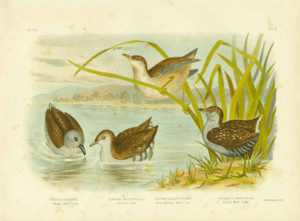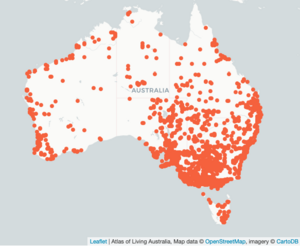Australian crake facts for kids
Quick facts for kids Australian crake |
|
|---|---|
 |
|
| In New South Wales, Australia | |
| Conservation status | |
| Scientific classification | |
| Genus: |
Porzana
|
| Species: |
fluminea
|
The Australian crake (also called the Australian spotted crake) is a small, shy bird that lives in Australia. It belongs to the Rallidae family, which includes rails and coots. This bird is the only type of Australian crake in its group, called Porzana.
Contents
Naming the Australian Crake
The Australian crake was first officially described in 1843. An English bird expert named John Gould gave it its scientific name, Porzana fluminea. He noted that this bird was found in New South Wales, Australia.
The word fluminea comes from a Latin word meaning "river." This makes sense because these birds often live near rivers and wetlands. This species is "monotypic," which means there are no different types or subspecies of Australian crake.
What Does the Australian Crake Look Like?
The Australian crake is a small bird, about 19 to 23 centimeters (7.5 to 9 inches) long. It weighs around 55 to 70 grams (about 2 ounces). Its wings can spread out 27 to 33 centimeters (10.5 to 13 inches) wide.
It looks a bit like another bird called Baillon's crake. However, the Australian crake is a bit plumper and darker. It also does not have the striped tail feathers that Baillon's crake has.
Colors and Markings
The Australian crake has a dark, sooty face. Its chest, belly, and throat are a dark steel-blue or grey color. Its upper body, including its head, is brown with black and white streaks. The sides of its body have black and white stripes.
When it lifts its tail, you can see a clear upside-down V shape. This is made by its black and white undertail feathers. When it flies, you might notice a white edge on its outer wing feathers.
Beak, Legs, and Eyes
The bird's beak is yellow-green, with a red base on the top part. Its legs and feet are also yellow-green. The Australian crake has bright red eyes.
Differences Between Males and Females
It is hard to tell male and female Australian crakes apart just by looking at them. Females are usually a little smaller and paler than males. They might have a brown stripe near their eyes and more white spots on their chest and neck.
Young Crakes
Younger birds are even paler. Baby crakes, called chicks, have very soft, fluffy black feathers with a deep green shine. They also have a bright red mark at the base of their upper beak.
Where Do Australian Crakes Live?
The Australian crake is a bird that is only found in Australia. You can see them across southeast and Western Australia. They are less common in Tasmania and the warmer, northern parts of Australia.
These birds live in many different places, both near the coast and inland. They like freshwater, salty water, and even land areas. They prefer places with lots of thick plants, like marshes, swamps, and saltmarshes. They especially like areas with plants like lignum, rushes, and sedges.
Where these birds live can change depending on how much water there is. After heavy rains, they might spread further inland to places like Alice Springs/Mparntwe.
How Australian Crakes Live
What Do Australian Crakes Eat?
Australian crakes often look for food in pairs or family groups. Sometimes, if there is a lot of food, many crakes (up to 100!) will gather together. They like to find food in thick plants, on muddy ground, or in shallow water (less than 5 centimeters deep).
They eat many different things, including:
- Water plants and algae
- Seeds
- Snails and small crabs
- Spiders
- Tadpoles
- Many kinds of insects, both adults and their young
These birds find food by poking their beaks into the ground. They also wade or swim, sometimes putting their heads underwater. If they catch a big piece of food, they might hit it against the ground near the water's edge to break it up.
How Australian Crakes Raise Their Young
Australian crakes usually breed between August and February. They build their nests over or next to water, about 2 to 50 centimeters (1 to 20 inches) above the waterline. They use reeds, rushes, grasses, and small bushes to build their nests.
They often add more rushes or grasses over the nest, making it look like an upside-down dome. They might also flatten some plants to create a ramp or stage leading up to the nest. Sometimes, many nests from different pairs are found close together, with up to 30 nests in one area.
A female crake lays 3 to 6 eggs. The eggs are pale brown with dark brown, red-brown, and black spots. Both parents take turns sitting on the eggs to keep them warm. When the chicks hatch, they are able to move around soon after. Both the male and female parent help to look after the young birds.
Protecting the Australian Crake
The Australian crake is currently listed as a species of "Least Concern." This means it is not in immediate danger of disappearing. However, there are still threats to these birds.
These threats include:
- Loss of their habitat (the places where they live)
- Animals that are not native to Australia, like feral cats and foxes
- Farming and animals like cows eating their plants
- Climate change
Because of these threats, it is very important to protect wetlands. Wetlands are the marshy, watery areas where Australian crakes live. Protecting these places is key to making sure this species survives for a long time.




